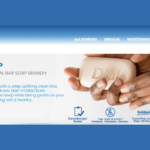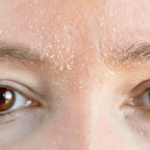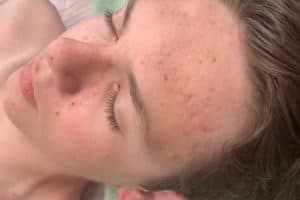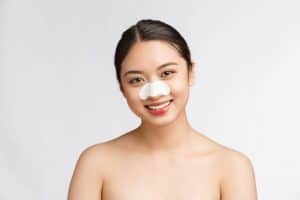Does the mere thought of using facial oils make you cringe? Ever thought about using a facial oil but were afraid of waking up to a greasy face or face full of pimples?
I understand the concern! This is because oils may work amazingly for one person but horribly for another.
I’ve tried many facial oils and have a shortlist of my favorite.
Our top 3 picks for the best natural face oil for acne-prone skin are:
- Sea Buckthorn Berry Oil
- Tomato Seed Oil
- Prickly Pear Seed Oil
Although there are quite a number of facial oils available for the skin, I actually looked at 79 different oils, which I narrowed down through several factors. And though there are a lot of beneficial facial oils out there (several of which I discussed in an older post), I am going to focus on three that are not quite as common or heard of.
How I based it on was oil that you could use for dry aging skin all the way down to the other end of the spectrum for acne skin or breakout-prone skin, as well as the availability–how available it was to be able to purchase and longer shelf-life.
A lot of oils, especially nut-based oils, don’t last as long. They go rancid very quickly, so I looked at the shelf-life and the pricing. I want everyone who decides to use facial oil to get the most bang for their buck. Meaning that it has a whole array of beneficial ingredients in the oil.
Difference Between Serums and Facial Oils
If you are wondering what the difference is between a facial oil and a serum… Serums are lightweight moisturizers that penetrate deeper into the skin to deliver active ingredients into it.
Regular use of serum can give your skin a firmer, smoother texture, make pores appear smaller, and increase moisture levels. Serums are always going to be absorbed a lot quicker because they can be distributed more efficiently and more concentrated.
Facial oils harness the power of natural botanical oil or oils for various skincare benefits. It is believed by many cosmetic chemists and skincare practitioners that oils better penetrate the surface layers of the skin than a moisturizer.
However, the results can vary. They don’t penetrate as efficiently as a serum but can bring similar benefits and are praised by many who enjoy their natural properties.
Oleic vs Linoleic Acid
Generally speaking, oils are higher in oleic acid, and they are better in treating dry skin. Oils that are higher in oleic acid tend to be a little bit heavier. They tend to be thicker. They are occlusive, so they don’t add moisture to the skin. Occlusive means it sits on top of the skin, and it prevents moisture that you already have in your skin from escaping or evaporating.
If you already have skin that doesn’t have enough moisture, it is not going to add more moisture to your skin. Because it does tend to have an occlusive effect on the skin, it tends to clog pores in some skin types, so this is better for people who have dry skin, and they don’t produce enough oil.
They also have a longer shelf life than oil with higher linoleic acid. But the oils that are higher in oleic acid tend to have more anti-inflammatory properties, and they have more skin-softening properties.
Now, people with oily skin or breakout-prone skin (for those of you who can use a facial oil because there are some of you who can’t use it at all) tend to do better with oils that are higher in linoleic acid, and that is because the consistency of that is a lot thinner.
It’s a lot smoother, and how it can help the skin is it actually helps restore the skin’s own natural barrier function, so it prevents scaling of the skin.
Best Natural Face Oil for Acne-Prone Skin
Sea Buckthorn Berry Oil
The first one is the Sea Buckthorn Berry Oil. It rates really low on the comedogenic scale, so what that means is it’s really low in causing clogged pores. It also has a longer shelf life, and it is easier to acquire. It also has a really high absorption rate, so it’s really good for skin conditions whether you have really dry skin, itchy skin, eczema skin, as well as acne-prone skin.
It’s also great for wrinkles because it’s really high in antioxidants, flavonoids, and keratins. I’ve also heard the benefit of applying sea buckthorn berry oil to your hair or eyelashes to promote growth and health. It is best to try a small amount at a time to see if it works for you. Then if so, you can increase the amount and frequency you apply the oil.
It has vitamins A, C, and E, as well as lycopene, which, as you know, are the antioxidants that improve skin metabolism. They lessen wrinkles and improve the skin’s ability to renew its own brand new skin cells. And it is the only known plant source that has the complete omega family—omega 3, 6, 7, and 9.
It also prevents as well as neutralizes glycation, which is an aging process that breaks down collagen and elastin. It neutralizes glycation, which is great for a natural oil.
Tomato Seed Oil
The next one is Tomato Seed Oil. This one also has a longer shelf life. It has a high absorption rate. It is really low on the comedogenic scale as well (so it won’t clog the pores), and it is best used for skin conditions such as eczema, psoriasis, dry skin, aging skin, and age spots.
It’s also loaded with antioxidants such as carotenoids, phytosterols, and flavonoids. These all help neutralize the free radicals that age your skin.
Prickly Pear Seed Oil
The last one is Prickly Pear Seed Oil or Barbary Fig Oil. This also has a longer shelf life. It is lower on the comedogenic scale. Not as low as the other two that I mentioned, but it’s still fairly low. It’s also great for aging skin as well as acne because, again, it’s filled with a lot of antioxidants.
This seed oil has 150% more vitamin E than argan oil, and again, this is filled with carotenoids, flavonoids, and vitamin C, so it is a great oil for aging.
Now, why is this great for those who tend to have oily skin or breakout-prone skin? This oil actually helps minimize the appearance of larger pores. So it actually tightens up the pores. It actually helps with hydration.
It helps increase your skin’s ability to hold in moisture. It can also help to combat dark, swollen, puffy eyes, wrinkles, and fine lines. Or you can use it as a daily hand moisturizer to prevent dryness and maintain healthy nails.
So remember, if you have serious hyperpigmentation or age spots or some pretty serious acne, serums are always going to be better because they have better delivery systems. They can penetrate more efficiently and effectively into your skin, and they also have a higher amount of performance ingredients versus natural facial oils.
But it’s worth trying oils as they do benefit many people and can be easier to obtain than the serum. So try these three oils to see how they work on your skin!
Conclusion – Best Natural Face Oil for Acne-Prone Skin
Our top 3 picks for the best natural face oil for acne-prone skin are:
- Sea Buckthorn Berry Oil
- Tomato Seed Oil
- Prickly Pear Seed Oil
There are many other natural face oils you can try, but I have found over the years of trial and error for these three to have a lasting effect. They all feel amazing when applied to the skin, and you should see an improvement in your acne within 2 to 3 weeks of consistent daily use.
Related Questions
What oils clog pores? Oils range on a scale of how much they will clog your pores, if at all. Oils that will clog your pores include avocado oil, chia seed oil, sesame oil, as well as cocoa butter, and shea butter. You should avoid these oils if you have oily skin and clogged pores.
Does grape seed oil clog pores? Grape-seed has a very low likelihood of clogging pores. It has anti-inflammatory properties, contains high levels of linoleic acid, and is a commonly used moisturizer for acne-prone and sensitive skin.
Do you put face oil on before or after moisturizer? Some apply face oil before their moisturizer, and some apply it after. It depends on the moisturizer you use and whether it is thin or thick. If it is thin, then it is best to add the oil after to lock in the moisture.

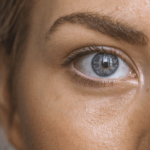
![How to Get Dead Skin Off Lips [6 Natural Remedies] how to get dead skin off lips](https://skincaregeeks.com/wp-content/uploads/2021/04/how-to-get-dead-skin-off-lips-150x150.jpg)

